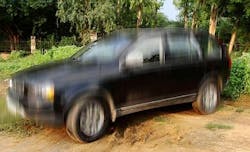Air Force to use vibration sensors that identify and target intruding cars and trucks
Officials of the Air Force Research Laboratory at Wright-Patterson Air Force Base, Ohio, announced an upcoming program this week for the Vibrometry Interrogation for Battlefield Exploitation (VIBE). A formal solicitation for the VIBE program is expected in January.
VIBE will seek to develop combat identification and automatic target recognition using for vibrometry sensor data gathered on vehicles from inside anti-access and denied areas.
Laser vibrometry technology today is mature enough for automatic target-recognition capabilities, Air Force researchers say. Vibrometry sensors use micro-Doppler technology to measure the engine vibrations of military and civilian vehicles.
Related: Raytheon develops computer-equipped sensor to locate tunnels and land mines
This can provide additional non-imagery identification of potential trespassers or attackers at ranges beyond the abilities of traditional electro-optical sensors. Vibrometry also can assess vibration signatures for facility interrogation, power plant assessment, obscured targets, and battle damage assessment (BDA), researchers say.
Developing automated digital signal processing for these vibration signatures is a critical step in delivering the technology to the warfighter. Vibration signatures sensed from distant vehicles can help analysts determine engine type, engine speed, number of cylinders, vehicle type, or a fingerprint of the target for identification and recognition.
Researchers previously have trained vibration-detection algorithms on identical vehicles, and determined that factors like sensing location, state of engine degradation and tuning, engine operating conditions, and structural loading can vary measurements even from the same vehicle.
One of the VIBE program's key challenges will be to extracting features from vibrometry signatures that remain consistent, and filter out irrelevant noise.
Related: Piezoelectric accelerometers for general-purpose vibration test introduced by Meggitt
For this project Air Force researchers are not interested in any proprietary hardware, software, or data solutions. Instead, the program will focus on basic algorithm development. Program funding will be about $15 million from 2016 to 2022, researchers say.
Until the formal solicitation is released in January, Air Force researchers are not ready to take industry proposals. For questions or concerns contact the Air Force's Regina Williams by email at [email protected] or by phone at 937-713-9977. Also contact Michael Wafzig by email at [email protected] or by phone at 937-713-9979.
More information is online at https://www.fbo.gov/spg/USAF/AFMC/AFRLWRS/BAA-AFRL-RQKS-2016-0005/listing.html.

